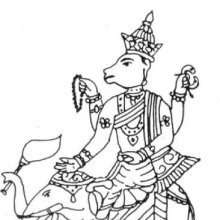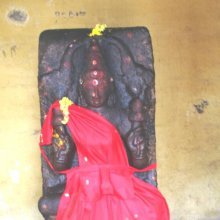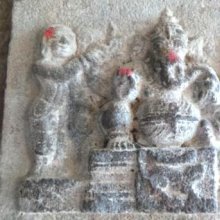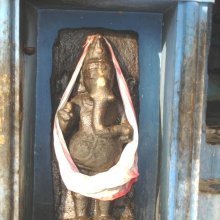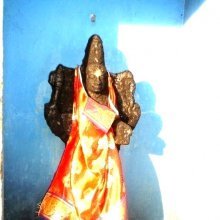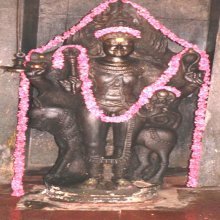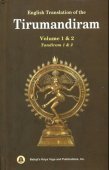Pasha, Pāsa, Pāśa, Pāśā, Pasa: 45 definitions
Introduction:
Pasha means something in Buddhism, Pali, Hinduism, Sanskrit, Jainism, Prakrit, the history of ancient India, Marathi, Hindi, biology. If you want to know the exact meaning, history, etymology or English translation of this term then check out the descriptions on this page. Add your comment or reference to a book if you want to contribute to this summary article.
The Sanskrit terms Pāśa and Pāśā can be transliterated into English as Pasa or Pasha, using the IAST transliteration scheme (?).
Alternative spellings of this word include Paas.
Images (photo gallery)
(+9 more images available)
In Hinduism
Natyashastra (theatrics and dramaturgy)
Source: archive.org: The mirror of gesture (abhinaya-darpana)One of the saṃyutta-hastāni (Twenty-four combined Hands).—Pāśa (noose) : the forefingers of the Sūci hand are bent and interlocked. Usage: enmity, noose, manacles.

Natyashastra (नाट्यशास्त्र, nāṭyaśāstra) refers to both the ancient Indian tradition (shastra) of performing arts, (natya—theatrics, drama, dance, music), as well as the name of a Sanskrit work dealing with these subjects. It also teaches the rules for composing Dramatic plays (nataka), construction and performance of Theater, and Poetic works (kavya).
Shilpashastra (iconography)
Source: Google Books: The Theory of Citrasutras in Indian PaintingPāśa (पाश, ‘noose’) is a weapon (āyudha or bādhra) according to the Vāstusūtra Upaniṣad.
Source: Google Books: Elements of Hindu iconographyPāśa.—As the word indicates, it is a noose of ropes employed in the binding the enemy’s hands and legs. It is represented in sculptures as consisting of two or event three ropes made into a single or a double loop.
Source: Red Zambala: Hindu Icons and Symbols | Inner Circle IVThe noose (pāśa) of Gaṇeśa — represents the three things which are the cause of our bondage to the material world which necessitate continued rebirth:
- Avidyā—Ignorance of our true nature
- Karma—Our actions done in conformity with the false identification with the material vehicle
- Vāsanā—The habitual pattern formations which we create.
Pāśa (Noose) - The 3 bonds that bind us to the cycle of rebirth – avidya (ignorance) karma (action) vāsanā (habitual patterns). It also has three other meanings attracting oneself to the Dharma, tying oneself by the constraints of Dharma and destroying all obstacles to one’s spiritual evolution.
Source: Shodhganga: The significance of the mūla-beras (śilpa)Pāśa (पाश) refers to “noose” or “rope weapon” and represents one of the several “attributes” (āyudha) or “accessories” of a detiy commonly seen depicted in Hindu iconography, defined according to texts dealing with śilpa (arts and crafs), known as śilpaśāstras. Pāśa is a noose of ropes employed in binding the enemy’s hands and legs. [The Pāśa] is represented in sculptures as consisting of two or even three ropes made into a single or a double loop.
Pāśa also represents “transitory nature”, referring to one of the attributes of Lord Śiva.

Shilpashastra (शिल्पशास्त्र, śilpaśāstra) represents the ancient Indian science (shastra) of creative arts (shilpa) such as sculpture, iconography and painting. Closely related to Vastushastra (architecture), they often share the same literature.
Purana and Itihasa (epic history)
Source: Wisdom Library: Varāha-purāṇaPāśā (पाशा).—Name of a river originating from Vindhya, a holy mountain (kulaparvata) in Bhārata, according to the Varāhapurāṇa chapter 85. There are settlements (janapada) where Āryas and Mlecchas dwell who drink water from these rivers.
Bhārata is a region south of Hemādri, once ruled over by Bharata (son of Ṛṣabha), whose ancestral lineage can be traced back to Svāyambhuva Manu, who was created by Brahmā, who was in turn created by Nārāyaṇa, the unknowable all-pervasive primordial being.
The Varāhapurāṇa is categorised as a Mahāpurāṇa, and was originally composed of 24,000 metrical verses, possibly originating from before the 10th century. It is composed of two parts and Sūta is the main narrator.
Source: Google Books: Cultural History from the Vāyu PurānaPāśa (पाश, “noose” or “lasso”):—The pāśa was a sort of lariat or lasso. It is mentioned in the Ṛgveda as one of the weapons of Varuṇa and Soma. The Mahābhārata also makes allusions to it. The Vāyu-purāṇa mentions it only in connection with Śiva.
Source: archive.org: Puranic EncyclopediaPāśa (पाश).—A divine weapon of Varuṇa. There is nothing to excel this in swiftness. (Śloka 29, Chapter 41, Vana Parva).
Source: archive.org: Shiva Purana - English TranslationPāśa (पाश) refers to the “cords and chains” (of a chariot), according to the Śivapurāṇa 2.5.8 (“The detailed description of the chariot etc.”).—Accordingly, as Sanatkumāra narrated to Vyāsa: “The divine chariot of lord Śiva consisting of all the worlds was built by Viśvakarman with devoted effort. [...] The Lokāloka mountain formed its side steps. The lake Mānasa etc. constituted its brilliant outer and oblique steps. The Varṣa mountains constituted the cords and chains (pāśa) all round the chariot [pāśāssamaṃtatastasya sarve varṣācalāssmṛtāḥ ]. All the residents of the region Tala constituted the bottom surface of the chariot. [...]”
Source: Cologne Digital Sanskrit Dictionaries: The Purana Index1) Pāśa (पाश).—Noose peculiar to Varuṇa.*
- * Matsya-purāṇa 135. 77; 150. 128; 152. 2; 153. 211; 162. 31; 173. 12; 174. 13.
2) Pāśā (पाशा).—A river from the Pāriyātra.*
- * Brahmāṇḍa-purāṇa II. 16. 28.

The Purana (पुराण, purāṇas) refers to Sanskrit literature preserving ancient India’s vast cultural history, including historical legends, religious ceremonies, various arts and sciences. The eighteen mahapuranas total over 400,000 shlokas (metrical couplets) and date to at least several centuries BCE.
Shaivism (Shaiva philosophy)
Source: Google Books: Manthanabhairavatantram (shaivism)Pāśa (पाश) refers to a “noose” and represents one of the attributes of Svacchanda, according to the Śrīmatottara-tantra, an expansion of the Kubjikāmatatantra: the earliest popular and most authoritative Tantra of the Kubjikā cult. Accordingly, “O goddess, Svacchanda is in the middle, within the abode of the triangle. Very powerful, he has five faces with three times five flaming eyes. [...] O fair lady, my attributes—trident, dagger, sword, the king of the snakes, and rosary—adorn the right (arms). O beloved, a skull, double-headed drum, javelin, noose [i.e., pāśa] and goad—(these) are my divine, brilliant and very auspicious weapons that (are held) in the left (hands). The king of snakes (hangs) on the shoulder and a garland of skulls hangs (from the neck). There is a necklace of scorpions around the throat and the ears are adorned with snakes. [...]”.
Source: A History of Indian Philosophy Volume 5: Śiva-jñāna-bodhaPāśa (पाश).—According to the Mṛgendrāgama, the pāśa is really the tirodhānaśakti of Śiva. The pāśas are threefold:
- sahaja, those malas with which we are associated from beginningless time and which stay on until liberation;
- āgantuka, meaning all our senses and sense-objects; and
- sūṃsargika, that is those which are produced by the intercourse of sahaja and the āgantuka mala.
The creation and the manifestation of our experiences take place in accordance with our karma as revealed by God. Just as a field sown with seeds does not produce the same kind of crop for every peasant, so in spite of same kinds of actions we may have different kinds of results manifested to us by God.
Source: A History of Indian Philosophy Volume 5: Śaiva Philosophy according to Bhoja and his commentatorsPāśa (पाश, “bonds”).—The bonds or pāśa are of four kinds: first, the bond of mala and the karma. The bond of mala is beginningless, and it stands as a veil over our enlightenment and power of action. The karma also flows on, depending on the mala from beginningless time. The third is called māyēya, which means the subtle and gross bodies produced through māyā, which is the fourth. Aghora-śivācārya says that māyēyameans the contingent bonds of passion, etc., which are produced in consequence of karma. Even those who have not the māyēya impurity at the time of dissolution (pralaya) remain by themselves but not liberated.
Source: Shodhganga: Temple management in the ĀgamasPāśa (पाश) refers to one of the various Devatā weapons and represents a type of “temple implement (instrument)” as described in the Karaṇalakṣaṇavidhi-paṭala section of the Uttara-Kāmikāgama.—The instruments should be according to the particular śāstra followed at the temple. Some of the instruments mentioned are weapons of all Devatās including [viz., pāśa].
Source: Brill: Śaivism and the Tantric TraditionsPāśa (पाश) refers to “bonds”, according to the Svacchandatantra verse 4.79b-81b.—Accordingly, “Next there is the initiation for the purpose of the purification of the cosmic path for those who seek the fruit of [either] enjoyment or liberation. The subtle method that causes the cutting of the bonds (pāśa-vicchitti-kāraka) is explained. The Guru asks the candidate seeking benefits [about] the two-fold [option]. Whatever fruit he desires, accordingly he should start the propitiation of Mantras”.

Shaiva (शैव, śaiva) or Shaivism (śaivism) represents a tradition of Hinduism worshiping Shiva as the supreme being. Closely related to Shaktism, Shaiva literature includes a range of scriptures, including Tantras, while the root of this tradition may be traced back to the ancient Vedas.
Kavya (poetry)
Source: OpenEdition books: Vividhatīrthakalpaḥ (Kāvya)1) Pāsa (पास) is the name of an ancient teacher, mentioned in the Vividhatīrthakalpa by Jinaprabhasūri (13th century A.D.): an ancient text devoted to various Jaina holy places (tīrthas).—Accordingly, “[...] While Kesi, a disciple of Pāsa, is a follower of the four vows (the vow of chastity is implicitly included in the vow of no lust), Goama, faithful to the doctrine of Mahāvīra, recognizes five vows. Faced with the doubts of their disciples, Kesi and Goama meet for a verbal confrontation. Goama succeeds in convincing Kesi of the necessity of the vow of chastity. [...]”.
Cf. Uttarādhyayanasūtra XXIII v. 1-29: Jacobi SBE XLV p. 119-123.
2) Pāsa (पास) in Prakrit (or Pāśa in Sanskrit) refers to a “chain”, as is mentioned in the Vividhatīrthakalpa by Jinaprabhasūri (13th century A.D.): an ancient text devoted to various Jaina holy places (tīrthas).

Kavya (काव्य, kavya) refers to Sanskrit poetry, a popular ancient Indian tradition of literature. There have been many Sanskrit poets over the ages, hailing from ancient India and beyond. This topic includes mahakavya, or ‘epic poetry’ and natya, or ‘dramatic poetry’.
Shaktism (Shakta philosophy)
Source: Google Books: ManthanabhairavatantramPāśa (पाश) refers to a “noose” and is used to visualize Bhairava, according to the Manthānabhairavatantra, a vast sprawling work that belongs to a corpus of Tantric texts concerned with the worship of the goddess Kubjikā.—Accordingly, “He has eight faces and, very powerful, shines like a white lotus. He is mightily proud and has sharp teeth and great body. He is terrible and fierce and his face is deformed. O Śambhu, he has twenty arms and the goddess sits on his lap. He holds a sword, mallet and noose [i.e., pāśa], a double-headed drum, a dagger, the Kaustubha jewel, a rosary, a skull bowl full of fruit and the like and a piece of human flesh. [...]”.
Source: Brill: Śaivism and the Tantric Traditions (shaktism)Pāśa (पाश) refers to “(holding the) noose”, according to the King Vatsarāja’s Pūjāstuti called the Kāmasiddhistuti (also Vāmakeśvarīstuti), guiding one through the worship of the Goddess Nityā.—Accordingly, “[...] I approach the great temple of goddess Mṛḍānī that opens to the west. It is guarded outside by Indra and the other [gods who guard the directions], and shines beautifully with utmost richness. I venerate the young elephant-faced master of Śiva’s gaṇas, the destroyer of obstacles. His lotus-hands are decorated with a noose, goad (pāśa-aṅkuśa), fruit, and lotus. [...]

Shakta (शाक्त, śākta) or Shaktism (śāktism) represents a tradition of Hinduism where the Goddess (Devi) is revered and worshipped. Shakta literature includes a range of scriptures, including various Agamas and Tantras, although its roots may be traced back to the Vedas.
Sports, Arts and Entertainment (wordly enjoyments)
Source: archive.org: Syainika Sastra of Rudradeva with English Translation (art)Pāśa (पाश) refers to the “jesses (of the hawk)”, according to the Śyainika-śāstra: a Sanskrit treatise dealing with the divisions and benefits of Hunting and Hawking, written by Rājā Rudradeva (or Candradeva) in possibly the 13th century.—Accordingly, “The casting [of hawks] is of two kinds—Hastamoka and Muṣṭimoka. [...] Hastamoka is that in which the jesses of the hawk are held (pāśa-pīḍana) by the fingers and the hawk is cast at the quarry, This is the only method in the case of Kuhīs (Shahin), and one of the best in the case of the Bāsā (Sparrow-hawk)”.

This section covers the skills and profiencies of the Kalas (“performing arts”) and Shastras (“sciences”) involving ancient Indian traditions of sports, games, arts, entertainment, love-making and other means of wordly enjoyments. Traditionally these topics were dealt with in Sanskrit treatises explaing the philosophy and the justification of enjoying the pleasures of the senses.
General definition (in Hinduism)
Source: Wisdom Library: HinduismPāśa (पाश, “noose”):—One of the objects that Yama is displayed carrying. Yama, the vedic God of death, represents the embodiment of Dharma. Yama rules over the kingdom of the dead and binds humankind according to the fruits of their karma.
In Buddhism
Theravada (major branch of Buddhism)
Source: Pali Kanon: Pali Proper NamesA locality in South India, captured by Lankapura. Cv.lxxvi.236.
Theravāda is a major branch of Buddhism having the the Pali canon (tipitaka) as their canonical literature, which includes the vinaya-pitaka (monastic rules), the sutta-pitaka (Buddhist sermons) and the abhidhamma-pitaka (philosophy and psychology).
Tibetan Buddhism (Vajrayana or tantric Buddhism)
Source: academia.edu: The Structure and Meanings of the Heruka MaṇḍalaPāśa (पाश) refers to a “noose” and represents one of the items held in the left hand of Heruka: one of the main deities of the Herukamaṇḍala described in the 10th century Ḍākārṇava chapter 15. Heruka is positioned in the Lotus (padma) at the center; He is the origin of all heroes; He has 17 faces (with three eyes on each) and 76 arms [holding, for example, pāśa]; He is half black and half green in color; He is dancing on a flaming sun placed on Bhairava and Kālarātrī.
Source: OSU Press: Cakrasamvara Samadhi1) Pāśa (पाश) refers to a “noose” which is used to describe Cakrasaṃvara, according to the Saṃvaramaṇḍala of Abhayākaragupta’s Niṣpannayogāvalī, p. 45 and n. 145; (Cf. Cakrasaṃvaratantra, Gray, David B., 2007).—Accordingly, [while describing the iconography of Cakrasaṃvara]: “In the Saṃvara Maṇḍala atop Mount Sumera within a vajra-canopy there is a variegated lotus, on top of that a palace, in the middle of which is the Blessed Lord, standing in ālīḍhāsana, "archer's pose", [...] possessing a vyāghracarma, "tiger skin" and twelve arms, the foremost arms holding a vajra and ghaṇṭā, embracing Vajravārāhī, the uppermost arms holding a gajacarman, "elephant skin", dripping with blood, the remaining arms holding, starting second from the top, on the right, a ḍamaru, "double-headed drum", paraśu, "axe", kartika, "flaying knife", triśūla, "trident", on the left, a khaṭvāṅga, "staff", kapāla, "skull bowl", pāśa, "noose", and brahmamuṇḍa, "lopped head of Brahma", [...]”.
Note: The pāśa, "noose", symbolizes having removed all delusions (moha).
2) Pāśa (पाश) refers to an “edge”, according to the Cakrasaṃvara Samādhi [i.e., Cakrasamvara Meditation] ritual often performed in combination with the Cakrasaṃvara Samādhi, which refers to the primary pūjā and sādhanā practice of Newah Mahāyāna-Vajrayāna Buddhists in Nepal.—Accordingly, “A red twilight, producing a sharp essence, an edge as bright as seven suns (pāśa-saptārka-kānti), A knife killing all enemies, a gleaming immortal striker held by the right arm”.

Tibetan Buddhism includes schools such as Nyingma, Kadampa, Kagyu and Gelug. Their primary canon of literature is divided in two broad categories: The Kangyur, which consists of Buddha’s words, and the Tengyur, which includes commentaries from various sources. Esotericism and tantra techniques (vajrayāna) are collected indepently.
In Jainism
General definition (in Jainism)
Source: The University of Sydney: A study of the Twelve Reflections1) Pāśa (पाश) refers to the “bonds (of life)”, according to the 11th century Jñānārṇava, a treatise on Jain Yoga in roughly 2200 Sanskrit verses composed by Śubhacandra.—Accordingly, “In abiding-in-objects [meditation], there are to be known five acts of concentration described by the heroes [of the past]. The one who is restrained who is expert in them cuts through the bonds of life (janman-pāśa)”.
2) Pāśa (पाश) refers to the “noose” (of Yama), according to the Jñānārṇava.—Accordingly, “Fool, there is no embodied soul in the three worlds for whom the noose (pāśa) of Yama (i.e. the god of death) will not stretch on [their] neck. The sentient being descends into the path of Yama’s lion which is irresistible. He certainly is not protected even by the energetic 30”.
2) Pāśa (पाश) or Karmapāśa refers to the “noose (of action)”, according to the Jñānārṇava.—Accordingly, “That [cosmos] is not at all produced by anyone, not at all sustained by anyone, so also not destroyed by anyone. Nevertheless, that exists by itself without support in the atmosphere. [...] Wherein all these living beings abiding in the various states of existence are born [and] die subject to the noose of action (karmapāśa-vaśaṃgata)”.

Jainism is an Indian religion of Dharma whose doctrine revolves around harmlessness (ahimsa) towards every living being. The two major branches (Digambara and Svetambara) of Jainism stimulate self-control (or, shramana, ‘self-reliance’) and spiritual development through a path of peace for the soul to progess to the ultimate goal.
India history and geography
Source: Cologne Digital Sanskrit Dictionaries: Indian Epigraphical GlossaryPāśa.—(CII 4), fetters of worldly existence. (IA 18), a land measure. (EI 26), a girdle. Note: pāśa is defined in the “Indian epigraphical glossary” as it can be found on ancient inscriptions commonly written in Sanskrit, Prakrit or Dravidian languages.

The history of India traces the identification of countries, villages, towns and other regions of India, as well as mythology, zoology, royal dynasties, rulers, tribes, local festivities and traditions and regional languages. Ancient India enjoyed religious freedom and encourages the path of Dharma, a concept common to Buddhism, Hinduism, and Jainism.
Biology (plants and animals)
Source: Google Books: CRC World Dictionary (Regional names)Pasa in Philippines is the name of a plant defined with Areca catechu in various botanical sources. This page contains potential references in Ayurveda, modern medicine, and other folk traditions or local practices It has the synonym Areca catechu Willdenow (among others).
Example references for further research on medicinal uses or toxicity (see latin names for full list):
· Species Plantarum. (1805)
· Nucleus (1975)
· Flora Cochinchinensis (1790)
· Flora Indica, or ‘Descriptions of Indian Plants’ (1768)
· Species Plantarum
· Taxon (1979)
If you are looking for specific details regarding Pasa, for example extract dosage, chemical composition, side effects, health benefits, pregnancy safety, diet and recipes, have a look at these references.

This sections includes definitions from the five kingdoms of living things: Animals, Plants, Fungi, Protists and Monera. It will include both the official binomial nomenclature (scientific names usually in Latin) as well as regional spellings and variants.
Languages of India and abroad
Pali-English dictionary
Source: BuddhaSasana: Concise Pali-English Dictionarypāsa : (m.) a sling; a snare; a button hole.
Source: Sutta: The Pali Text Society's Pali-English Dictionary1) Pāsa, 3 (a stone?) at PvA. 63 (pās’antare) is probably a misreading and to be corrected to palāsa (palās’antare, similarly to rukkh’antare, kaṭṭh’— and mūl’antare), foliage. (Page 456)
2) Pāsa, 2 (Class. Sk. prāsa fr. pra+as) a spear, a throw Sn. 303; A. IV, 171 (kuṭhāri° throw of an axe).—asi° a class of deities Miln. 191. (Page 456)
3) Pāsa, 1 (Vedic pāśa) a sling, snare, tie, fetter S. I, 105, 111; A. II, 182; IV, 197; Vin. IV, 153 (? hattha°); Sn. 166; It. 36 (Māra°); J. III, 184; IV, 414; PvA. 206. On its frequent use in similes see J. P. T. S. 1907, 111. (Page 456)

Pali is the language of the Tipiṭaka, which is the sacred canon of Theravāda Buddhism and contains much of the Buddha’s speech. Closeley related to Sanskrit, both languages are used interchangeably between religions.
Marathi-English dictionary
Source: DDSA: The Molesworth Marathi and English Dictionarypasā (पसा).—m (prasṛti S) The palm hollowed and the fingers compressed (to take up water, grain &c.) 2 W The cavity formed by the hollowing and joining of both palms. ulathā pasā pālathā pasā g. of s. Profuse, wasteful, thriftless housekeeping or procedure. paśācēṃ pāya- līsa uṭhēnā Used where one, willing at the first (to go or do) for some slight consideration, insists now upon exorbitant terms.
--- OR ---
pāśa (पाश).—m (S) A noose or running knot; a tie or confining cord; a snare or net for catching birds and beasts; a net gen. 2 fig. Any ensnaring, enfettering, encumbering, obstructing (business, state of circumstances, disposition of objects). Ex. bhavapāśa, prapañcapāśa, kālapāśa, snēhapāśa, mōhapāśa, mṛtyu- pāśa, yamapāśa, nāgapāśa, māyāpāśa, āśāpāśa, mamatā- pāśa, kuṭumbapāśa. 3 A die (to play with).
--- OR ---
pāsa (पास).—prep (Poetry.) Near or nigh unto.
--- OR ---
pāsa (पास).—f The iron share of a kuḷava (a harrow). Used, by synecdoche, for the implement (kuḷava) itself. 2 Silver melted down into a bar (usually of thirty-five tolas) in preparation for making lace &c.
Source: DDSA: The Aryabhusan school dictionary, Marathi-Englishpasā (पसा).—m The palm hollowed and the fingers compressed (to take up water, grain &c.) The cavity formed by the hollowing and joining of both palms. ulathā pasā pālathā pasā Thrift- less housekeeping of procedure. paśācēṃ pāyalīsa uṭhēnā Used where one, willing at the first (to go or do) for some slight consideration, insists now upon exorbitant terms.
--- OR ---
pāśa (पाश).—m A noose. A snare or net. Fig. Ensnaring. A die (to play with).
--- OR ---
pāsa (पास).—prep Near or nigh to. f The iron share of harrow.
Marathi is an Indo-European language having over 70 million native speakers people in (predominantly) Maharashtra India. Marathi, like many other Indo-Aryan languages, evolved from early forms of Prakrit, which itself is a subset of Sanskrit, one of the most ancient languages of the world.
Sanskrit dictionary
Source: DDSA: The practical Sanskrit-English dictionaryPāśa (पाश).—[paśyate badhyate'nena, paś-karaṇe ghañ]
1) A cord, chain, fetter, noose; पादाकृष्टव्रततिवलयासंगसंजातपाशः (pādākṛṣṭavratativalayāsaṃgasaṃjātapāśaḥ) Ś.1.32; बाहुपाशेन व्यापादिता (bāhupāśena vyāpāditā) Mṛcchakaṭika 9; R.6.84.
2) A snare, trap or net for catching birds and beasts.
3) A noose used as a weapon (as by Varuṇa); किं चायमरिदुर्वारः पाणौ पाशः प्रचेतसः (kiṃ cāyamaridurvāraḥ pāṇau pāśaḥ pracetasaḥ) Kumārasambhava 2.21.
4) A die, dice; Malli. on R.6.18.
5) The edge or border of anything woven.
6) (With Jainas) The outer world, nature.
7) (At the end of comp.) पाश (pāśa) expresses (a) contempt or depreciation; as in छात्रपाशः (chātrapāśaḥ) a bad pupil; वैयाकरण°, भिषक्° (vaiyākaraṇa°, bhiṣak°) &c.; (b) beauty or admiration; as in सैवोष्ठमुद्रा स च कर्णपाशः (saivoṣṭhamudrā sa ca karṇapāśaḥ) Uttararāmacarita 6.27; (c) abundance, mass, or quantity (after a word signifying 'hair'); as in केशपाश (keśapāśa) q. v.
-śī A rope, fetter; पाशीकल्पामायतामाचकर्ष (pāśīkalpāmāyatāmācakarṣa) Śiśupālavadha 18. 57.
Derivable forms: pāśaḥ (पाशः).
Source: Cologne Digital Sanskrit Dictionaries: Edgerton Buddhist Hybrid Sanskrit DictionaryPāśā (पाशा).—(?) , f. = Sanskrit pāśa, mass: Lalitavistara 357.9 (verse); see s.v. ūrṇākośa.
--- OR ---
Pāsa (पास).—(-pāsa) (ka) , f. -ikā, ifc. (Pali sūci-pāsa, Vism. 284.14), eye (of a needle), in vaṭṭa-p°, q.v., Mahāvastu ii.87.17; text °yāsikā; same verse in Pali, Jātaka (Pali) iii.282.13, su-pāsiyaṃ (v.l. °kaṃ), acc. sg. with sūciṃ; commentary sundarena suviddhena pāsena samannāgatattā supāsiyaṃ (suggesting that -iya or -ka, -ikā, accompanies the [bahuvrīhi] [compound] only); and, in fact, pāse (loc.) occurs in the prose iii.282.3, 5, with vijjhi(tvā), where the translators render wrongly dice; rather, piercing (the needle) at the (place for the) eye. From Sanskrit pāśa, loop ? A Deśī word (Deśīnāmamālā 6.75) pāsa = akṣi, eye, is recorded. Hindi āṅkh, eye, is given the meaning hole of a needle (sūī kā ched) in Hindī Śabdasāgara (1914), 1 p. 312, s.v. āṅkh, meaning 4; I have found no confirmation of this, or of any use of a word for eye, of a needle's eye, in any Indian dialect, in any other source. The Hindi usage (evidently limited) could possibly be explained as due to English influence. Professor W.N. Brown informs me that the common Hindi word for eye of a needle is nākā. However, Jäschke (Tibetan-English Dictionary) says that Tibetan mig, regularly eye, also means eye of a needle, and hole for the handle of a hatchet etc.
Source: Cologne Digital Sanskrit Dictionaries: Shabda-Sagara Sanskrit-English DictionaryPāśa (पाश).—m.
(-śaḥ) 1. A fetter, a chain, a tie, the string for fastening tamed animals, or the net or noose for catching birds, deer, &c. 2. A noose as a weapon of combat. 3. A die. 4. In composition with words signifying “hair,” denotes quantity, as keśapāśaḥ much or flowing hair. 5. In composition with karṇa, denotes “beauty,” as karṇapāśaḥ a handsome ear. 6. in compoition with chatra and other words expresses “contempt” or “depreciation,” as chatrapāśaḥ an inelegant or shabby umbrella; bhiṣak pāś “a bad physician &c.” E. paś to bind, aff. ghañ; where it is used in composition, it is in fact but a technical aff.
Source: Cologne Digital Sanskrit Dictionaries: Benfey Sanskrit-English DictionaryPāśa (पाश).—i. e. paś + a, m. 1. A tie, a string, a chain, a fetter, Mahābhārata 1, 6749. 2. A string for fastening tamed animals. 3. A net or noose for catcing birds, [Hitopadeśa] 21, 10. 4. A noose as principal attribute of Varuṇa, [Rāmāyaṇa] 3, 54, 9 (cf. the Vedas).
Source: Cologne Digital Sanskrit Dictionaries: Cappeller Sanskrit-English DictionaryPāśa (पाश).—[masculine] bond, snare, trap (lit. & [figuratively]).
Source: Cologne Digital Sanskrit Dictionaries: Monier-Williams Sanskrit-English Dictionary1) Pāśa (पाश):—m. (once n. ifc. f(ā). ; [from] √3. paś) a snare, trap, noose, tie, bond, cord, chain, fetter ([literally] and [figuratively]), [Ṛg-veda] etc. etc.
2) ([especially]) the noose as attribute of Śiva or Yama, [Religious Thought and Life in India 81; 290]
3) (with Jainas) anything that binds or fetters the soul id est. the outer world, nature, [Sarvadarśana-saṃgraha] (cf. also, [Religious Thought and Life in India 89])
4) selvage, edge, border (of anything woven), [Gṛhya-sūtra and śrauta-sūtra]
5) a die, dice, [Mahābhārata]
6) (in [astrology]) a [particular] constellation
7) a [particular] land-measure, [Inscriptions]
8) (ifc. it expresses either contempt e.g. chattra-p, ‘a shabby umbrella’, or admiration e.g. karṇa-p, ‘a beautiful ear’; after a word signifying, ‘hair’ abundance, quantity e.g. keśa-p, ‘a mass of hair’)
9) Pāsa (पास):—m. [varia lectio] for yāsa
Source: Cologne Digital Sanskrit Dictionaries: Yates Sanskrit-English DictionaryPāśa (पाश):—(śaḥ) 1. m. A fetter, a chain, a noose, a net. keśa-pāśa much hair; karṇa-pāśa a fine ear; chatra-pāśa a bad or shabby umbrella.
Source: DDSA: Paia-sadda-mahannavo; a comprehensive Prakrit Hindi dictionary (S)Pāśa (पाश) in the Sanskrit language is related to the Prakrit word: Pāsa.
[Sanskrit to German]
Sanskrit, also spelled संस्कृतम् (saṃskṛtam), is an ancient language of India commonly seen as the grandmother of the Indo-European language family (even English!). Closely allied with Prakrit and Pali, Sanskrit is more exhaustive in both grammar and terms and has the most extensive collection of literature in the world, greatly surpassing its sister-languages Greek and Latin.
Hindi dictionary
Source: DDSA: A practical Hindi-English dictionary1) Pasā (पसा):—(nm) the two handfuls; as much as can be held in both hands joined in a cup-like structure.
2) Pāśa (पाश) [Also spelled pash]:—(nm) a bond, tie; noose; snare, trap; fetter; chain; mass; lock (as [keśa]~); an instrument used for sprinkling/spraying (as [gulābapāśa]); ~[baṃdha] a bond; snare; ~[baddha] in bond, snared, in fetters.
3) Pāsa (पास) [Also spelled paas]:—(nm) a pass; (adv) near by, in the neighbourhood of; (a) passed, not failed; -[kā] near; close by, proximal, located in the vicinity/neighbourhood;—[pāsa] near, side by side; close by; ~[vāna] a neighbour; an attendant; a watchman/guard; hence ~[vānī] (nf); —[jānā] to go near; to be intimate; to cohabit with; —[taka na phaṭakanā] not to go anywhere near, to keep absolutely aloof, to keep at an arm’s length (from); —[honā] to get through; to pass.
4) Pāsā (पासा):—(nm) a dice; die; —[paḍanā] the die to be cast favourably, to be favoured by luck, to have a spell of good luck;—[palaṭanā] the tide to be turned, to have a changed run of luck; —[pheṃkanā] to cast the die; to try one’s luck; —[sīdhā paḍanā] the die to be cast favourably, one’s effort to succeed.
...
Prakrit-English dictionary
Source: DDSA: Paia-sadda-mahannavo; a comprehensive Prakrit Hindi dictionary1) Pāsa (पास) in the Prakrit language is related to the Sanskrit word: Ddaś.
2) Pāsa (पास) also relates to the Sanskrit word: Pārśva.
3) Pāsa (पास) also relates to the Sanskrit word: Pāśa.
4) Pāsa (पास) also relates to the Sanskrit word: Pāśa.
Prakrit is an ancient language closely associated with both Pali and Sanskrit. Jain literature is often composed in this language or sub-dialects, such as the Agamas and their commentaries which are written in Ardhamagadhi and Maharashtri Prakrit. The earliest extant texts can be dated to as early as the 4th century BCE although core portions might be older.
Kannada-English dictionary
Source: Alar: Kannada-English corpusPasa (ಪಸ):—
1) [noun] an acute and general shortage of food (caused by drought) or a period of this; famine.
2) [noun] a desire; yearning; a longing for.
3) [noun] covetousness; avariciousness; greed.
4) [noun] the quality of being impatiently eager.
5) [noun] (fig.) hunger; starvation.
--- OR ---
Pasa (ಪಸ):—
1) [noun] a beautiful, charming, attractive thing.
2) [noun] a pure, clean thing.
3) [noun] that which is good, better or appropriate.
4) [noun] a variety of good quality arecanut.
5) [noun] the quality or condition of being clean, pure; cleanliness; purity.
6) [noun] the state of doing well esp. in respect to good fortune, happiness, well-being or prosperity; welfare.
7) [noun] the quality of being appropriate, suitable, fitting, etc.; appropriateness; propriety.
--- OR ---
Pāśa (ಪಾಶ):—
1) [noun] a length of a rope.
2) [noun] a piece of rope having a noose at one end.
3) [noun] the condition of being imprisoned or under the control of another; imprisonment.
4) [noun] a trap or net for catching animals.
5) [noun] unbraided hair.
6) [noun] anything dangerous, risky, etc. that tempts or attracts; a thing by which a person is entangled; a trap; a snare.
7) [noun] a die or dice used in the game of chance.
8) [noun] (a term, used as the second term in a compound word, meaning) abundance, beauty, shabbines, admiration, etc.
9) [noun] (phil.) the condition of being bound by the worldly attachments.
10) [noun] anything that binds or fetters the soul.
11) [noun] (astrol.) a condition in which seven astrological planets are stationed in five zodiacal houses.
12) [noun] (dance.) one of the twenty four hand gestures (made using both the hands).
--- OR ---
Pāṣa (ಪಾಷ):—
1) [noun] a muslim king or emperor; a sultan.
2) [noun] a rich, influential man.
--- OR ---
Pāsa (ಪಾಸ):—[noun] = ಪಾಶ [pasha].
--- OR ---
Pāsa (ಪಾಸ):—[noun] a vow or practice of taking one’s supper before sunset.
Kannada is a Dravidian language (as opposed to the Indo-European language family) mainly spoken in the southwestern region of India.
Nepali dictionary
Source: unoes: Nepali-English Dictionary1) Pasā (पसा):—n. grace; mercy; favor;
2) Pāśa (पाश):—n. 1. a cord; chain; fetter; noose; 2. a snare; trap or net for catching birds or beasts; 3. a noose used as weapon; 4. a die; dice;
3) Pāsa (पास):—n. 1. pass; the act of passing an examination; success in the examination; 2. pass; ticket/entry card;
4) Pāsa (पास):—n. 1. nearness; proximity; 2. → पाश [pāśa]
5) Pāsa (पास):—adj. 1. competent; skilled; 2. accepted; acknowledged;
6) Pāsa (पास):—pp. near; beside;
7) Pāsa (पास):—adv. near; by;
8) Pāsā (पासा):—n. 1. playing with dice; 2. a die/dice;
9) Pāsā (पासा):—n. pl. of पासो [pāso]
Nepali is the primary language of the Nepalese people counting almost 20 million native speakers. The country of Nepal is situated in the Himalaya mountain range to the north of India.
See also (Relevant definitions)
Starts with (+153): Pasai, Pasaka, Pasakusuma, Pasamti, Pasana, Pasanacceti, Pasandaka, Pasandika, Pasanta, Pasava, Pasavi, Pashabaddha, Pashabandha, Pashabandhaka, Pashabandhana, Pashabhidhana, Pashabhrit, Pashaccheda, Pashadhara, Pashadharin.
Ends with (+107): Adhipasha, Alpasha, Amoghapasha, Anamgapasha, Ankapasha, Annapasha, Antrapasha, Anurupasha, Apasha, Apaspasha, Argalapasha, Ashapasha, Ashtapasha, Aupasha, Bahupasha, Bandhapasha, Bhavapasha, Bhishakpasha, Bhujapasha, Bhumipasha.
Full-text (+365): Pasas, Pashabandha, Pashapani, Pashabandhaka, Kacapasha, Padapasha, Pasharajju, Pashadhara, Dharmapasha, Pashahasta, Kutapasa, Kalapasha, Avicritya, Nagapasha, Pashila, Nitshapin, Pashabaddha, Keshapasha, Bhishakpasha, Pasaka.
Relevant text
Search found 87 books and stories containing Pasha, Pāsa, Pāśa, Pāśā, Pasa, Pāsā, Pasā, Pāṣa; (plurals include: Pashas, Pāsas, Pāśas, Pāśās, Pasas, Pāsās, Pasās, Pāṣas). You can also click to the full overview containing English textual excerpts. Below are direct links for the most relevant articles:
Rig Veda (translation and commentary) (by H. H. Wilson)
A History of Indian Philosophy Volume 5 (by Surendranath Dasgupta)
Part 3 - Śiva-jñāna-bodha < [Chapter XXXIV - Literature of Southern Śaivism]
Part 4 - Śaiva Philosophy according to Bhoja and his commentators < [Chapter XXXVIII - Śaiva Philosophy in some of the Important texts]
Part 3 - Māṇikka-vāchakar and Śaiva Siddhānta < [Chapter XXXVIII - Śaiva Philosophy in some of the Important texts]
Sahitya-kaumudi by Baladeva Vidyabhushana (by Gaurapada Dāsa)
Text 10.35 < [Chapter 10 - Ornaments of Meaning]
Text 10.42 < [Chapter 10 - Ornaments of Meaning]
Text 5.2 < [Chapter 5 - Second-rate Poetry]
Sivaprakasam (Study in Bondage and Liberation) (by N. Veerappan)
Concept of Self and its Intelligence < [Chapter 3 - Understanding the Self]
Introduction (The concept of God) < [Chapter 4 - Concept of God]
Sat and Asat < [Chapter 3 - Understanding the Self]
Varahi Tantra (English Study) (by Roberta Pamio)
Chapter 12 - The Dhyānas (supports for the meditation) of the Goddess < [Summary of the Vārāhī Tantra]
Chapter 29 - The worship of Caṇḍikā < [Summary of the Vārāhī Tantra]
Chapter 28 - Durgāpūjā (the worship of Durgā) < [Summary of the Vārāhī Tantra]
The Shiva Purana (by J. L. Shastri)
Chapter 2 - The glory of lord Śiva < [Section 7.2 - Vāyavīya-saṃhitā (2)]
Chapter 6 - The Principles of Śiva cult (2) < [Section 7.1 - Vāyavīya-saṃhitā (1)]
Chapter 5 - The Principles of Śiva cult < [Section 7.1 - Vāyavīya-saṃhitā (1)]
Related products
